How Much Hair is Normal to Lose in the Shower?
To find the real cause of excess shedding, look at what else is happening in your life.
Are you under a lot of stress? Do you have issues with anxiety or depression? Have you changed any of your beauty or hygiene habits lately?
Stress, anxiety, and depression can all contribute to excessive hair loss. It's important to remember that our hair is a direct reflection of our overall health.
How Much Hair is Normal to Shed When Washing it?
Are you losing more hair than usual when you shower or brush your hair? You need to find out why this is happening.
The first step is to understand how your hair and body work together to grow hair. Hair grows in three cycles: anagen, catagen, and telogen phases. (2)
The anagen phase is the active growth phase of the hair follicle. It lasts between two and six years, depending on the area of the body where the follicle is located.

During this phase, cells divide quickly to form new cells pushed up from below, causing the root of the hair to grow at a rate of about 1 cm each month. The growing strand of hair pushes older cells above, forming a club-like structure called a "club hair."
The catagen phase follows for one to two weeks. During this time, the club hair moves upward toward the skin's surface as new cells are formed at its base. Then it stops moving upward, and all growth activity stops completely for about one week. This is believed to be part of the natural resting process for scalp hair follicles
The telogen phase is the resting phase that lasts for approximately 100 days; only 5 percent of your scalp hairs are in this phase at any given time. About one-third of all adults experience some level of hair loss each year.
Causes of Excessive Hair Shedding
Hair loss is a common problem that affects men and women of all ages. Whether it's a result of genetics, ageing, stress, or a medical condition, hair loss can be a very upsetting experience.The most important thing to do if you're experiencing any hair loss is to have it checked by your doctor. It could be stress-related or due to a medical condition. Your doctor may recommend medication to help you if you suffer from temporary hair loss due to stress. (3)

If you're having issues with excessive hair loss, here are some questions to ask yourself:
- Have you changed your diet recently?
- Do you have an unhealthy diet?
- Do you have enough magnesium, zinc, vitamin B-12 or iron in your body?
- Are you drinking enough water every day?
You need to understand the causes of excessive hair shedding to take the proper steps towards preventing it.
Follow a Good Diet and Proper Vitamins 4
There are many reasons to experience hair loss, but you can learn how to ensure you're following a good diet and the proper vitamins.
If you are experiencing excessive shedding of hair, there are several things you can do. First, check with your physician because it could be a sign of anaemia or another medical condition. If everything is okay with your health, then look at the foods you eat. Ensure that your diet consists of plenty of protein (eggs, fish) and iron (lean meats). (4)

Then make sure that you're taking the proper daily vitamins, which include Biotin (also known as vitamin H or coenzyme R), folic acid (a B vitamin), Vitamin A (found in carrots), Vitamin C (found in citrus fruits), Vitamin E (found in wheat germ oil and almonds), and zinc (found in oysters). These will help in the development of new cells in your body, including your hair follicles. Make sure that you're getting enough rest during the day too! This will give your hair follicles time to properly regenerate after their growth cycle has ended for the day.
How to Test Your Shedding Level of the Hair?
To do the test, pull out one strand of hair from the top of your brush after running it through your hair for a few minutes. Try not to yank too hard because that may cause hairs that aren't ready to fall out yet to come out prematurely.
The amount of hair you shed daily varies from person to person. Some people lose over 100 strands per day, while others only lose 10 or 20 strands. The average person sheds between 50-100 strands each day. (5)

If you pull out more than ten strands of hair each day, you should see your doctor next week to schedule a physical exam. You may want to take a photo of your brush every morning so you can keep track of the amount of hair being removed. This way, if you have excessive shedding visit your doctor, who will order a blood test and other diagnostic tests if necessary.
Ill-effects of Shampoo and Conditioner
Research has shown that sulfates in shampoo and conditioner strip the natural oils out of your hair and scalp, leading to dandruff, eczema, and an increased amount of shedding after each wash. (6)
The first step to minimizing shedding is to replace your shampoo and conditioner with sulfate-free versions that will repair the damage done by traditional products. The second step is to reduce shampooing as much as possible.
Choosing the right shampoo is crucial in preventing excessive shedding due to shampoo use. You should avoid using shampoos that are too concentrated or that contain sodium laurel sulfate (SLS). This ingredient is found in many household detergents and can also be found in some shampoos and other components that are not good for colour-treated or fine/thin hair types.
Treatment Options for Helping in Hair Shedding
Topical drugs like Minoxidil are applied directly on the scalp to treat underlying issues like dandruff, scalp infections, bacterial imbalance. However, please consult a physician before using drugs to know about the prescribed application and frequency.
Laser is another option for helping with hair shedding. The laser helps stimulate blood flow to the scalp and promote healthy follicle growth in the area where the laser is applied. Waxing can also help in removing dead hairs in the area of application. (7)
Cryotherapy/cold therapy is another option for reducing hair shedding in the shower. It helps minimize the itchiness that comes with hair shedding and encourages new hair growth by reducing inflammation around the follicle. Medications are sometimes used with cryotherapy to help promote hair growth faster.
Conclusion
Hair loss or hair shedding is a natural phenomenon that affects both men and women. This process causes the hair to fall out in clumps or single strands, leaving bald patches on your scalp. With time, new hair grows in its place. Hair loss is often associated with ageing, but this can occur at any age. Hair loss is often associated with ageing, but this can occur at any age.(8)
Sometimes hair loss is normal, sometimes not! Learn how to tell the difference.
Myth Busters HairFall

Androgenetic Alopecia - Everything You Need To Know
Have you been experiencing excessive hair fall over a prolonged period of time? It could be an early sign of androgenetic alopecia. It is a hair loss disorder common in both genders and can lead to progressive thinning and even baldness in some patients if not caught and treated early.

How To Make Hair Grow Faster For Men
A head full of healthy hair is a matter of confidence. Hair has its own mechanism of growing and shedding, and it is when this mechanism is thrown off that growth is hindered. Especially in the case of males, hair growth faces a lot of hiccups that can easily be managed.

Female Pattern Baldness - Causes & Treatments
Have you suddenly noticed an increase in the number of hair strands on your pillow in the morning? Or is your ponytail getting thinner by day? Well, you might be suffering from female pattern baldness. While that does sound scary, identifying it early on is key to treating this condition effectively. So keep reading to know what this is, how you can identify it, and most importantly, what treatments you can avail of to get your beautiful lustrous hair back.

What Are The Reasons For Hairfall?
Almost everyone experiences some amount of hair thinning over the years. Shedding around 50 to 100 single strands of hair per day is considered normal. However, losing more than 150 strands a day, experiencing sudden thinning, or developing circular bald patches on your scalp are reasons for concern. Hair loss occurs when new hair doesn’t grow fast enough to replace the amount of hair you lose daily. Hair can fall due to various reasons, with hereditary hair loss and poor nutrition being the most common hair fall reasons.

Expert Approved Tips For Hair Growth
What can be more debilitating than seeing hundreds of hair strands shedding from your scalp every time you brush your hair? Also, excessive molting occurs during seasonal changes that can be very stressful for you. Although it’s okay to lose between 50-100 strands every day, according to the American Academy of Dermatology, the problem occurs when you start shedding more than normal. But that doesn’t mean you have to feel helpless as there are ways to grow your hair back. Even if you are coping with baldness or alopecia, certain hair growth tips from dermatologists can come to your rescue. Read on to discover how these tips can be your savior when abnormal hair fall problems are in sight.
Trending Videos
+ 8 Sources
'LMRC - GGI-CO-A2-DMA-300001252-300001252-WM-L21-704'
© 2021 Dr. Reddy’s Laboratories Ltd. All rights reserved.